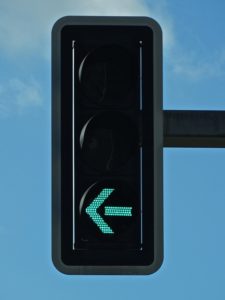
The proper use of turn signals is not only a crucial part of safe driving – in Virginia, it’s required by law.
Researchers estimated that a yearly average of almost 2 million accidents are caused by failure to properly use turn signals, according to a study conducted by the Society of Automotive Engineers (SAE). By using your signals correctly, you could significantly reduce your risk of being involved in a serious car accident.
When Should You Use Turn Signals?
Turn signals were designed for you to communicate with other drivers on the road. By signaling your intentions, you can let other drivers, cyclists, and pedestrians know what action they should take as well.
You should use your turn signals any time you intend to make a turn or change lanes.
How Failing to Use Your Turn Signal Can Cause an Accident
If you fail to use your turn signal, your risk of being involved in a vehicle collision is significantly increased. Some of the most common car accidents caused by the improper use of turn signals include:
- Being rear-ended by the car behind you
- Getting side-swiped by a car in another lane
- Being broadsided when turning in front of a car (also referred to as T-bone accidents)
How to Use Your Turn Signals Properly
Using your turn signal properly is fairly easy with practice. To correctly use your turn signal and reduce your risk of becoming involved in a car accident, follow these steps while driving:
- Locate your turn signal lever. In most vehicles, it is on the left side of the steering wheel column. If you move this lever up, it will create a signal to your right. If you move the lever down, it will signal to your left.
- To make a left turn, ensure that you are in the left turning lane. Wait until you are about 30 yards away from the corner where you plan to turn. Then, gently push the turn signal lever down to indicate that you intend to make a left turn. Be sure to turn on your signal before braking, so other drivers will know why you are slowing down.
- To make a right turn, ensure that you are in the right turning lane. Again, wait until you are about 30 yards away from the corner where you plan to turn. Then push your turn signal lever up to show other drivers that you plan to make a right turn. Although it may seem unnecessary, make sure that you use your turn signal even when driving in a turn-only lane. Communicating with other drivers is key to preventing accidents.
- To change lanes, activate your signal in the direction you intend to move before you slow down, speed up, or turn your steering wheel. After you have activated your turn signal, make sure that the lane you plan on merging with is clear by checking your side and rear-view mirrors. After you have made sure that the lane is clear, you can change lanes.
- Don’t activate your signal too soon. If there are streets or intersections between your car and your intended turn, refrain from activating your signal to early. Doing so could confuse other drivers, and potentially cause an accident.
Contact Ruloff, Swain, Haddad, Morecock, Talbert & Woodward, P.C.
In Virginia, using your turn signal isn’t just a safe driving practice – it’s the law. If you or someone have been injured in a car wreck because a driver failed to properly use their turn signal, they could owe you significant compensation.
Ruloff, Swain, Haddad, Morecock, Talbert & Woodward is a law firm dedicated to helping people who’ve been unjustly injured recover the money they need to rebuild their lives and move on after a crash caused by someone else’s negligence.
Reach out to us online or call us to schedule a free consultation to discuss your case.
